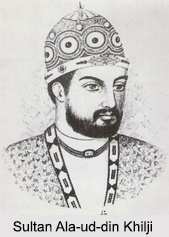 The kind and measurement of the land determined the land revenue in the time of the Delhi Sultanate. The land during the reign of the Delhi Sultanate was of four kinds. The land which was given to the people in gift or charity particularly to scholars and saints such as inam or waqf was free from tax. The land which was in the hands of provincial governors, that is walis or muqtis. The provincial governors collected revenue from this land and after defraying the cost of their administration deposited the surplus in the central treasury. The third land was of the feudatory Hindu chiefs who paid fixed tribute to the Sultan, and fourthly the land which was directly administered by the central government. It was called the Khalisa land. Primarily, this fourth kind of land came under the revenue administration of the Sultan.
The kind and measurement of the land determined the land revenue in the time of the Delhi Sultanate. The land during the reign of the Delhi Sultanate was of four kinds. The land which was given to the people in gift or charity particularly to scholars and saints such as inam or waqf was free from tax. The land which was in the hands of provincial governors, that is walis or muqtis. The provincial governors collected revenue from this land and after defraying the cost of their administration deposited the surplus in the central treasury. The third land was of the feudatory Hindu chiefs who paid fixed tribute to the Sultan, and fourthly the land which was directly administered by the central government. It was called the Khalisa land. Primarily, this fourth kind of land came under the revenue administration of the Sultan.
The central government appointed revenue collector in each sub-division called the shiq. He collected the revenues with the help of hereditary officers of the village like chaudharies, muqaddams, patwaris etc. the Sultan appointed one officer called Khwaja in every Iqta to look after the working of wali or muqti. The walis or muqtis submitted the statements of annual income and expenditure to the Sultan. Generally the peasants were asked to pay one third of the total produce to the state as land revenue. Mostly the revenue was collected in cash but Ala-ud-din Khilji collected it in kind from Doab and nearby territories of Delhi. Except Ala-ud-din and Muhammad Tughlaq no Sultan of Delhi collected revenue based on the measurement of land. Most of the Sultans collected it on the basis of rough assessment of the produce.
Ala-ud-din confiscated all land given as gifts or as charity by previous rulers and redistributed it among his loyal subjects. He also abolished all privileges of hereditary officers of villages like chaudharis, khuts, Muqaddams etc. and forced them to pay all taxes to the state like other peasants. Ghiyas-ud-din Tughlaq decided in the interests of the peasants that in no case the land-revenue should be enhanced more than 1/11 to 1/10 in any Iqta in any one year. Muhammad Tughlaq prepared an estimate of the annual income and expenditure of the state. He wanted that there should be uniformity in land revenue in his entire empire.
Firoz Tughlaq made a rough assessment of the entire land-revenue of the state and on that basis fixed the land-revenue for the entire period of his reign. He freed the peasant from the payment of taqavi loans, enhanced the salaries of revenue officers, abolished nearly twenty-four taxes, planted fruit gardens, dug many canals, imposed irrigation tax, and stopped the practice of imposing benevolences on the governors at the time of their appointments and also that of torturing officers to extract more money from them, the burden of which really used to fall upon the shoulders of the people. The measures of Firoz, though defective in some respects, certainly brought prosperity to the state and its people.
The revenue system during the period of Delhi Sultanate suffered from certain defects. The assessment of revenue without the measurement of land could not be just to the peasants. Besides, there were other taxes which the peasants had to pay beside the land-revenue and that certainly meant extra burden on them.






































